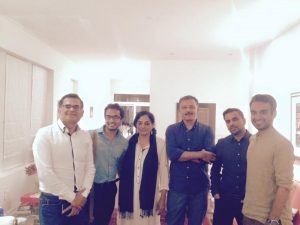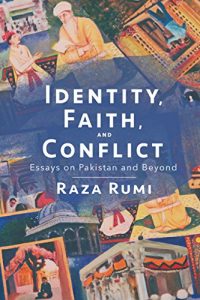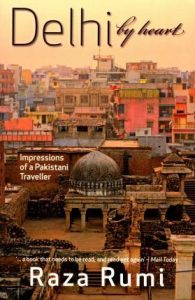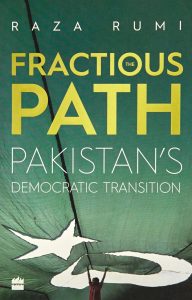What It Means to be a Pakistani, in Ithaca and the Indian Subcontinent – An Interview with Raza Rumi
Interview by Daneesh Majid

The interviewer, Daneesh Majid (second from left) with the author Raza Rumi (at the center, fourth from left).
A man who has donned many hats and still continues to do so, Raza Rumi has always viewed not just his homeland Pakistan, but also its Siamese twin India through various lenses. As a policy analyst, journalist, civil servant, development expert, or literary connoisseur, he has quite the grasp on regional political and cultural dynamics. His first book Delhi By Heart: Impressions of a Pakistani Traveller reminds various South Asians how certain cities in “hostile” lands are not exactly a long way from “home.” In 2014, Rumi moved to the United States after a tragic, failed assassination attempt (in Pakistan) on him due to his overt stance against rapidly proliferating Islamist fundamentalist elements. Yet, he continued to wield his pen as Editor of The Friday Times, teach at various universities like Ithaca College, Cornell, NYU, and contributed his diverse expertise at United States Institute of Peace, and the National Endowment for Democracy (NED) as a Visiting Fellow in Washington, DC. While at NED, his collection of essays for Pakistani weekly The News on Sunday were compiled in his sophomore release The Fractious Path: Pakistan’s Democratic Transition and Identity.
Rumi’s latest book Being Pakistani: Society, Culture, and Arts is in certain ways, a continuation of his third offering Identity, Faith and Conflict: Essays on Pakistan and Beyond. Not only do they contain academic, personal, and long-form journalistic insight into South Asia before AND after he transplanted himself onto American soil, but they also remind us of the ties that bind South Asians. Currently, he is based in Ithaca, New York where he is the Director of Ithaca College’s Park Center for Independent Media. He also teaches at the Cornell Institute for Public Affairs. Until recently, he was the editor of the English-language newspaper Daily Times. In 2018, he visited his native land nearly 5 years after the assassination attempt. This was also when his new book, Being Pakistani: Society, Culture, and Arts was released. He also founded a bi-lingual digital initiative Nayadaur Media that intends to challenge the mainstream narratives in Pakistani media and is a youth run platform. A conversation with Rumi attunes us to his trajectory from a native as well as a diaspora perspective.

Born and bought up in Lahore, you also spent certain intervals of your life in India, and your current abode of sorts, the United States. There is a chapter in your book called “The Enigma of Dual Belonging: Qurratulain Hyder’s Enduring Popularity in Pakistan”. Hyder’s Aag Ka Darya has a Muslim character who is a staunch Indian nationalist during independence/partition. He then migrates to Pakistan after facing discrimination despite his above educational and family background. Yet he comes to Karachi where other North Indians like him still feel like they belong to Karachi just as much as UP or Bihar.
Barring certain differences, would it be safe to infer that like one your favourite wordsmiths, Annie Apa, you have a dual belonging?
I would not call it dual belonging but rather multiple belongings. As I have grown older and lived in different countries, I began to realize that it is too limiting to identify yourself with one place and one home. In my case, I initially moved away for work to Kosovo and then the Philippines but returned to the homeland. In 2014, I decided to move out once again to the US, but this was more of an existential response to unfortunate events. Obviously my core identity is that of a Pakistani and Lahori in particular. However, at the same time I’m increasingly convinced of our global interconnectedness and what we see today in terms of the challenges posed by climate change and common problems all over the world. We belong everywhere. If we start belonging and limiting ourselves to one country or one village, then we are denying ourselves of the entire expanse—even in terms of identity—that the world offers.
You are proud of your Pakistani identity, yet I believe that you have had the dubious honour of being deemed an ‘Indian Agent’ like Fahmida Riaz who is featured in your book. Like her you also returned to Pakistan, albeit temporarily. What was it like going back? Do you consider yourself an overseas Pakistani or just a Pakistani? I ask this because in India, if you spend certain amount of years abroad, you are termed a Non Resident Indian (NRI) and thereby a different socio-economic entity for better or worse.
Well, this is a very difficult and complex question. Twice I worked abroad but I always chose to return. I will have to bore your readers with a bit of my story. I was once a civil servant you know. I joined the Pakistan Administrative Service when I was in my early 20s. I worked for many years with the government, learned a lot, and experienced the real feel of rural Punjab and the rest of Pakistan. This has formed my world view. It is here that I gained experiential knowledge of the colonial state structures that still exist and the disparate communities that inhabit Pakistan. Then I moved and worked for the UN in Kosovo. Later I was with the Asian Development Bank and was based in the Philippines for some time. After traveling all over Southeast Asia, I returned to Pakistan because that is home at the end of the day. Hence, there is always this pull that you want to be home and that you want to contribute and engage. Within six years or so of my return, I had to leave again. As for going back that is a story in itself.
So I have accepted this nomadic existence of sorts. Perhaps that is my calling and I guess this is where I belong, which is basically everywhere or nowhere. On the issue of being called an Indian Agent, unfortunately there is an ultra-hawkish contingent in Pakistan that believes if you speak of peace with India or just a peaceful South Asia, you must be an agent of the enemy. The same holds true for India where so many people challenging the mainstream view are labeled as “anti-national”, anti-India, or simply traitors. That is the price one has to pay in questioning the jingoistic narratives. The problem in South Asia, in India, Pakistan, and Bangladesh too, is that we are essentially following and living through a colonial moment. The whole notion of a nation-state and Western nationalism are also colonial legacies in our region. We adhere to them and we end up limiting ourselves only to move towards jingoism. Why? Just to prove we are superior to the “other” or the enemy. While in reality, we are a very diverse and complex region with a shared history of over a thousand years. Any adaptation of nationalism or the nation-state simply cannot overlook this shared history and culture that spans centuries. Bringing out our shared past and attributes is quite the task. These were the themes I wanted to bring out when writing my first book. As a Pakistani I identified with Delhi — a city with a rich Muslim past. So I got into hot waters I suppose. But I still think that we have to continue attuning people to our shared history and culture.
Now you can call me a Non-Resident Pakistani because I have been living in the US for the last five years. This is where I guess I will be for some time, as I’m working here as well. This is a totally different experience and state of being for me. I’ve lived abroad. Travelled a lot. But being a resident elsewhere while your mind, your personal history, and your cultural affinities are in another place; it is a really unique experience. I don’t mind it. I’m also trying to make sense of it. Yet, I have simply experienced what all migrants and immigrants have gone through. So I’m not the first to whom this experience is unique and I’m surely not the last.
Your first book was a travelogue and you were definitely not a “diaspora” South Asian then. Unlike many Indians and Pakistanis, entering the “enemy” country for you was easy as your high-profile employer vouched for you during the visa application process. Plus, you didn’t have a European/North American passport that lets consulates/embassies overlook your Indian/Pakistani origins—at least early on in the visa application process. What was it like having that “Kya Dilli Kya Lahore” (What’s Delhi, What’s Lahore) luxury to traverse boundaries?
This exciting traversing of boundaries and the ability, at least for a short time, to subvert them was very exciting. That is how Delhi By Heart came into existence. Initially, I was in Delhi for work during my Asian Development Bank (ADB) days. Without the ADB affiliation, I might not have even gotten a visa. That was also the time when I began to write. I found an audience in India, and in Pakistan too. Soon enough, I found myself returning again and again to conferences and literary circuits. I met so many people and made such good friends.

Unfortunately, for the past six years I haven’t been to India. I don’t know when I can go next. I am rather sad that travel has become so difficult and what is happening within India is so worrisome. A dear friend is fighting cancer and I need to give her my support. As they say in the Sufi lore, I am waiting for the Delhi saints to intervene!
Coming back to your question, crossing certain man-made borders makes you realize the hollowness of these official definitions of nationalism, boundaries, and identities at the end of the day. Given that you know I’m from Punjab, there is such commonality between the Indian and Pakistani Punjabi. It is completely crazy to see how an iron curtain has been built over the years. Part of our struggle through writing and activism is to actually somehow dent these walls and move towards a rational and sensible future for our future generations.
The Fractious Path was a collection of your columns that spanned and examined the period of Pakistan between 2008 and 2013, which were basically transition years from a military regime to a civilian one. This era is looked at through the angles of its democratic transition, domestic security, extremism, governance, foreign policy, and media in the country. Granted those articles were written prior to your departure from Pakistan, but did the sheer distance away from home grant you a unique prism to retrospectively view this period?
The Fractious Path actually came out because these were longer pieces written for a newspaper magazine that publishes articles longer than standard op-eds. As you may have noticed, most of these commentaries weren’t the standard op-eds. This was when I was regularly contributing and commenting on a variety of affairs. I had signed a contract before I came to the US. When I came here, I started revisiting some of these pieces and eventually updating them. Distance definitely makes you think about those issues and reflect a little more. In a way, this collection was a humble attempt at documenting five years of civilian rule after General Musharraf.

An interesting time, 2008 was when nearly a decade of military rule came to an end, ushering in a newly elected civilian government. There was of course a lot of bloodshed and violence with the killing of Benazir Bhutto. Certainly, the political elites tried to reset the playbook by amending the constitution and bringing in civilian democratic features to Pakistan’s governance. I was writing commentaries on these changes once, sometimes twice, a week. I looked at those commentaries and the publishers thought that it might be a good idea to present and pitch it as a popular history of sorts.
Being Pakistani contains evocative long-form features and semi-academic write-ups, which straddle the sensitive line between political and personal regarding Pakistan’s seven decade long soul-searching journey. On a broad level, secularism and gender are recurring themes. The Fractious Path delved beyond looking at these two through the perspective of the American security establishment. Your recent book is replete with vestiges of an ethnolinguistic/religious syncretic past that includes Hinduism, rebel poets (be it Bulleh Shah or Jalib) and the feminism of Saadat Hasan Manto. How have these literary symbols of resistance helped you and others straddle this line between the personal and political?
Being Pakistani as you rightly say is a collection of much longer and relatively more serious pieces. Many were published but a few of them were unpublished. Some were just papers presented at conferences. This was kind of a collection of these pieces, as I have been writing on various issues of culture for more than a decade. I thought this was a good way to collate all of that. That is how the book came into being.
The themes of gender and secularism, which you have rightly identified, include the idea of there being no singular definition about what exactly is Pakistani culture. It is diverse since Pakistan is home to many languages, ethnicities, political opinions, and even different (re)-conceptions of Pakistan. That is the common theme that you may have noticed. The second most important part of these essays and the reason I put them together was also to present an alternative idea about Pakistan. In mainstream Indian media or even Western media, Pakistan is seen as a country where everybody is a mullah out to annihilate the West and/or the Hindu. In reality, there is a whole history of resistance, dissent, and struggle in Pakistan for a more democratic and inclusive society. It is still ongoing and this straddling of personal and political hasn’t always been new. Some of the essays revolve around those themes like resistance literature through which stalwarts like Manto, Fahmida Riaz, and others who dreamt and wrote about an alternative Pakistan. Exploring their works will simply attune us to how Pakistan continues to delicately straddle the personal and political.
There are different terms used to describe those who forgo their birthplace for another. Depending on various circumstances, they can be refugees, exiles, migrants in search of better social/economic opportunities, or broadly just another member of a diaspora. In the “Arts section” of your latest offering, you talk about some talented Pakistani artists who were trained at the premier institution, National College of Arts, Lahore but who have only honed their craft and made their mark in the US, kind of like an artistic brain drain. What category of immigrants are they?
You see this whole problem of looking at brain drain, whether it is artistic brain drain or technological brain drain…the reality is that since the end of the twentieth century, the world has become a different place. What we understand as globalization along with all its caveats has enabled the movement of people, skills, ideas, and technologies. So there were waves of immigration since the latter part of the twentieth century, especially to North America, where a lot of professionals settled down. For example, when I was a student at Aitchison College Lahore, the majority of my class went to pursue higher education in America. Most of them stayed back in America. It is basically the market forces at work. I think that is one part.
Another reason is that the migrant experience acquires and assumes a life of its own. It becomes a story and an inspiration in itself. The artists that I have mentioned in some of the essays are similarly inspired by their move, their adjustments, and interface with the new country and a new reality. I think it is very complicated to be honest. There is no straightforward way of looking at what happens to a migrant, and whether migrant artists are better or those at home are better. Both categories are excellent and deserved to be celebrated.
In Being Pakistani you briefly mention Annie Apa’s book Chandni Begum which talks about the dynamics between Muslim families that migrated to Pakistan while some of their relatives remained in India during partition. I have elder relatives who moved to Pakistan. Only in two scenarios have reunions been possible with them: 1) If they move to the Europe/North America/the Gulf and I happened to be living there or 2) They visited India during more peaceful times when it was relatively easy to get a visa. I don’t know if you have any “Indian” family anywhere but what have your interactions been like with NRIs on American soil?
No. I don’t have any relatives that I can call “Indian” because my mother’s family was in Amritsar and they all moved when Pakistan was created. My father’s family is from Old Lahore and they had been living there for centuries. In that sense I don’t have that split family syndrome that Annie Apa has written about or which your personal experience shows. But at the same time whenever me meet, I do feel that all over everyone is a relative of mine, whether it is a Bangladeshi, Indian, Nepalese, or Sri Lankan. We are tied by bonds of history, environment, culture, and climate, not to mention the DNA! Of course, since we are at some level creatures of the colonial era, the toxic bonds of colonialism have continued to bind us as well. That was the most recent, profound, and in some ways barbaric transformational time of our region. So if we are dealing with police in India, Pakistan, Sri Lanka, or Bangladesh, we are dealing with the same toxicity. If we are faced with a corrupt and slow bureaucrat or judge, it is the same reality. If we are fighting for water as well as natural resources, looking for sifarish (connections) to get something done, it is a shared reality. I know it is perverse but that is what ties us together. I have a clear perspective about my South Asian identity. I feel that I am a citizen of the globe, a Pakistani, and a Lahori of course. But I’m also a South Asian. The real art of living is negotiating your multiple identities and being comfortable with them.
There was a time when parochial, patriarchal Indian TV shows were popular among Pakistanis. You examine this deeply in an early chapter. However, like Bollywood to some extent, Pakistani dramas are very progressive in their portrayals of women. Unless you were an Indian abroad who saw how popular Humsafar was among Pakistanis in 2012, Indians only got to enjoy HUM TV and GEO TV dramas were shown on this side of the border from 2014-2016. Despite two paradoxical forces (women and mullahs) rising in the country as Intizar Hussain observed, why has Pakistani television managed to depict such strong female characters in its TV shows?
Pakistan’s popular culture, especially TV, short films, and music, have been outstanding in the past few decades. That is again, a story much less known to the world outside which associates Pakistan with war and violence alone. Conversely, look at the case of the music artist collaborations on Coke Studio. While I have problems with the commodification cum corporatization of culture and music, the kind of talent it continues to showcase is phenomenal. Similarly, Pakistani art practitioners who are emerging out of Pakistani art schools, Pakistani writers who write in English and local languages, or just the overall creativity in new media wave of cinema and TV is quite remarkable. This itself is a testament to the fact that for all its problems, Pakistan is a very vibrant country. There are perennial debates about what this country should be and the direction it takes.
Also, don’t forget the civil society movement. Only a decade ago, Pakistani society stood up against General Musharraf’s rule and paved the way for his ouster. It was a handful of lawyers who started it and then the entire civil society joined. That was quite a dramatic phase of our recent history. And in recent years new social movements led by students, women and youth in tribal districts are shaping public discourses.
All these events are precursors to why this TV culture is thriving. Of course, I will say that Pakistani TV, not unlike its Indian neighbour, has imbibed a lot of negative trends of patriarchy and the general mistreatment of women that subordinates them to stereotypical gender roles. This is something that Pakistan is following unfortunately. But there are many other plays that have strong female characters and bold themes being presented. There have been plays in the Islamic Republic that have dealt with issues such as sexuality, mental health, transpeople, and the excessive use of religion in the public sphere. All of this is happening in a country where radicals find prominence too. I think all of this shows in Initzar Hussain’s interview that I conducted where he talks about the role of women. I have mentioned in my book what Intizar Hussain told me about how in Pakistan he witnessed the rise of women and Mullahs. I have seen this in my own lifetime. There are more and more women in the Parliament, bureaucracy, public life, the private sector, bus stations, and departmental stores. This is certainly unlike the Zia Ul-Haq era that I grew up in. Things were far more conservative. I think it is the urbanization and the economic dynamics resulting in a different kind of society we are witnessing. At the same time, radicalization has also grown thereby making it most complicated and I guess dynamic too.
Clearly Pakistan is in the midst of a seven decade long soul-searching process with the country being multi-layered, and of course questioning its boundaries and definition. Some commentators use the term “Pakistanization of India” given the situation there. To what degree, if any, do you see “Pakistanization” happening in India? Because Faiz, Manto, and Jalib—icons of dissent evoked during Bhutto’s and Zia’s time—are also being elicited to resist the Modi regime in India.
As for this Pakistanization of India or Indianization of Pakistan, a few years ago I wrote a piece on this in a slim volume called Identity Faith and Conflict before these terms became popular. In that piece, I looked at how some of the toxic trends of Pakistani history and attempts at engineering the state were being replicated in India.
While it superficially seems that the Pakistanization or Indianization might be happening, the truth of the matter is that both the societies are in a huge flux. In India there has been a resurgence of pride in Hindu identity. The RSS-BJP narrative claims that Hindus have been conquered, undermined, and humiliated. The call to action from this narrative is that it is time to reclaim its hyper-masculine nationalistic strength. All of that is very problematic. It is very similar to how nationalism evolved in Western Europe and how it too acquired a hyper-masculine nature. Countless Germans were slaughtered over the definition of what constitutes being a ‘true’ German of pure blood. We also know how the Holocaust against the Jewish minority panned out. But India and Pakistan are different as well. They are responding to their colonial experience for it only ended seven decades ago. The process of detoxification is a long one.
The truth is that we need to de-colonize ourselves. We need to de-colonize the way we think about ourselves because this whole notion of a Hindu-India and a Muslim-Pakistan is very much a colonial construct after all. Look at the case of the Urdu and Hindi languages. The former is thought of as a Muslim language whereas the latter is considered as a Hindu one. In reality, Urdu and Hindi are more or less the same. A few hundred years ago, Urdu wasn’t referred to as Urdu; it was referred to as Hindavi. It was only with time and politics and how identities shaped in nineteenth century colonial India that Urdu became a Muslim language. The textbooks I grew up reading spoke of this Hindi-Urdu divide and how Pakistani nationalism predicates itself on Urdu. Now we are seeing a mirror image in India where Urdu is being spurned on the grounds of it being a Muslim language implanted by the so-called “invaders.” Though the reality is that it was born in that same Hindustan. So if somebody wants to expel it, it can’t be expelled, as it is part of that culture and lived reality.
How would we go about this process of de-colonizing ourselves?
Oh we have a long agenda ahead of de-colonization. The most important part of de-colonization is not just changing the names of your roads, cosmetic rebranding of civil service institutions or ‘tinkering’ with the various colonial era laws. It is about changing the way we think, produce and disseminate knowledge. It is how we perceive ourselves. In Pakistan, we think, rather unthinkingly, that the English language is sort of superior to our local languages. Being published in the West is seen as somehow more prestigious than being published in our homelands, and “foreign” goods/culture are superior to our native ones. These are all issues that surface in the political and economic system. Both countries are mired in neo-liberal economic structures. The rise of Modi and to some extent Imran Khan are somewhat representative of the aspirational middle classes seeking authoritarian leaders who can deliver economic miracles. It is a South Asian reaction to the neo-liberal global order.
Could you tell us about forthcoming projects of yours?
I have been working on a book that is a linear documentation of the year 2007 when Pakistan’s lawyers and civil society stood up against our military dictator Gen. Musharraf. Hopefully, that will be completed this year. Another project that is still a work in progress is a memoir – a personal narrative of transitions of transplanting oneself from one place to another and this perpetual state of homelessness which has more or less come to define my trajectory. Like the song goes, Musafir hoon yaaron, na ghar hain na thikana mujhe chalte jaana hai (Friends I am a wonderer and traveler, I don’t have have home and address).
But it is a tough project for emotional reasons. I am too overwhelmed by the sense of loss of being away from my country. Therefore, I have been rewriting what I initially penned mainly to find my real voice.
Works Cited
- Rumi, Raza. Delhi By Heart: Impressions of a Pakistani Traveller. Harper Collins, 2013.
- Rumi, Raza. The Fractious Path: Pakistan’s Democratic Transition. Harper Collins, 2016.
- Rumi, Raza. Being Pakistani: Society, Culture, and the Arts, 2016.
- Rumi, Raza. Identity, Faith, and Conflict: Essays on Pakistan and Beyond , 2018.
- Majid, Daneesh. “Reading Qurratulain Hyder’s ‘Aag Ka Darya’ in Contemporary India.” The Wire India, August 21, 2019.
- Haqqani, Husain, & Isphahani, Farhanaz. “We are seeing a Pakistanisation of India: Husain Haqqani.” You Tube, uploaded by The Print, February 21, 2018.
https://www.youtube.com/watch?v=gSv6GObndHk
![]()

Daneesh Majid is freelance writer from Hyderabad, India with an MA in South Asian Area Studies from the School of Oriental African Studies, University of London. His work has been featured in the regions’ prominent outlets including The Wire India, The Express Tribune and The Hindu Business Line—Ink. He enjoys reading and writing about Urdu poetry/literature as well as South Asian security/cultural/political dynamics. He tweets at @MajidDan. For more of his work, head to his website.



